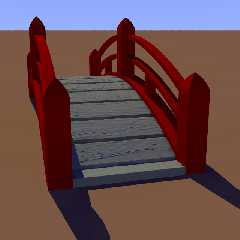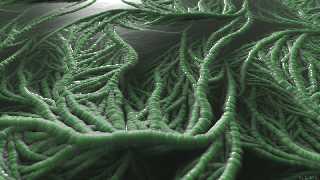 |
 |
|
 |
|
 |
|  |
|  |
|
 |
|
 |
|  |
|  |
|
 |
Not because this is such an outstanding scene, but just to show that
Sam's nice strand utility (povray.binaries.utilities newsgroup: a
texture generator for Windows: strands.exe; 13-9-2010 by Samuel Benge)
can be very useful when used in combination with the displacement
utility in Poseray. Here a produced strands image was used to displace
the floor boards of the bridge.
Thanks Sam!
Thomas
Post a reply to this message
Attachments:
Download 'object_test.png' (129 KB)
Preview of image 'object_test.png'

|
 |
|  |
|  |
|
 |
|
 |
|  |
|  |
|
 |
Thomas de Groot <tenDOTlnDOTretniATtoorgedDOTt> wrote:
> Not because this is such an outstanding scene, but just to show that
> Sam's nice strand utility (povray.binaries.utilities newsgroup: a
> texture generator for Windows: strands.exe; 13-9-2010 by Samuel Benge)
> can be very useful when used in combination with the displacement
> utility in Poseray. Here a produced strands image was used to displace
> the floor boards of the bridge.
>
> Thanks Sam!
>
> Thomas
Hmm, I figured nobody was using it; I'm glad that somebody is :)
Should I ever make a new version, I'll probably get a Bresenham line function
going (for efficiency), and maybe even investigate the possibility of having
antialiasing as an option.
I'll try to post some stuff generated by the utility soon. Hopefully I won't get
sidetracked like I usually do :)
Post a reply to this message
|
 |
|  |
|  |
|
 |
|
 |
|  |
|  |
|
 |
On 24-1-2012 2:12, Samuel Benge wrote:
> Hmm, I figured nobody was using it; I'm glad that somebody is :)
Well, like you say, I got sidetracked too :-) Only yesterday, while
messing around in my POV backyard, I came across it and thought about
what I could do with it, except making height_fields. This seemed one of
the interesting possibilities I wanted to share.
As the output of your utility has a strong 3D look, I was wondering if
there would be a possibility to render the strands in a 3 dimensional
way other than the classic height_fields, something like your fractals?
I suppose the voids would be the challenge...
>
> Should I ever make a new version, I'll probably get a Bresenham line function
> going (for efficiency), and maybe even investigate the possibility of having
> antialiasing as an option.
>
> I'll try to post some stuff generated by the utility soon. Hopefully I won't get
> sidetracked like I usually do :)
Very good! Nothing wrong with sidetracking though ;-)
Thomas
Post a reply to this message
|
 |
|  |
|  |
|
 |
|
 |
|  |
|  |
|
 |
Thomas de Groot <tenDOTlnDOTretniATtoorgedDOTt> wrote:
> On 24-1-2012 2:12, Samuel Benge wrote:
>
> > Hmm, I figured nobody was using it; I'm glad that somebody is :)
>
> Well, like you say, I got sidetracked too :-) Only yesterday, while
> messing around in my POV backyard, I came across it and thought about
> what I could do with it, except making height_fields. This seemed one of
> the interesting possibilities I wanted to share.
Other than height fields, mesh displacement and isosurfaces, I can't really
think of too many other applications where 16-bit precision would be useful.
Normals. The patterns themselves work well for texturing; you can get some
really interesting cracked paint going. I do have this frosted glass idea I've
kept in a box for years. Since it's winter, I should dig it back out :)
> As the output of your utility has a strong 3D look, I was wondering if
> there would be a possibility to render the strands in a 3 dimensional
> way other than the classic height_fields, something like your fractals?
> I suppose the voids would be the challenge...
Oh yeah, there is a way, and I've even got some DF3 code (Warp's, IIRC) which
would make things easier, but I'm not about to try it now. My queue is too full
ATM ;) But if I /were/ to do something like that, I'd probably use a 3D array
only to mark filled areas, and just generate cylinders or sphere_sweeps as it
works itself out. No DF3 needed for that. The result would look like webs, or
something, and could be displaced with functions...
> > I'll try to post some stuff generated by the utility soon. Hopefully I won't get
> > sidetracked like I usually do :)
>
> Very good! Nothing wrong with sidetracking though ;-)
Not at all! But I've got so many things I have never posted, just lots of parts
floating around on the HD. I keep telling myself I'll eventually assemble some
of them into a scene, but there's always another interesting concept to explore
:D
Sam
Post a reply to this message
|
 |
|  |
|  |
|
 |
|
 |
|  |
|  |
|
 |
On 24-1-2012 20:06, Samuel Benge wrote:
> Other than height fields, mesh displacement and isosurfaces, I can't really
> think of too many other applications where 16-bit precision would be useful.
> Normals. The patterns themselves work well for texturing; you can get some
> really interesting cracked paint going. I do have this frosted glass idea I've
> kept in a box for years. Since it's winter, I should dig it back out :)
Yes, I guess those are the main features. I shall have to play with
those ideas and see where I end up...
> Oh yeah, there is a way, and I've even got some DF3 code (Warp's, IIRC) which
> would make things easier, but I'm not about to try it now. My queue is too full
> ATM ;) But if I /were/ to do something like that, I'd probably use a 3D array
> only to mark filled areas, and just generate cylinders or sphere_sweeps as it
> works itself out. No DF3 needed for that. The result would look like webs, or
> something, and could be displaced with functions...
That sounds interesting indeed.
>
>>> I'll try to post some stuff generated by the utility soon. Hopefully I won't get
>>> sidetracked like I usually do :)
>>
>> Very good! Nothing wrong with sidetracking though ;-)
>
> Not at all! But I've got so many things I have never posted, just lots of parts
> floating around on the HD. I keep telling myself I'll eventually assemble some
> of them into a scene, but there's always another interesting concept to explore
> :D
Excellent, Sam! Keep up the good work.
Thomas
Post a reply to this message
|
 |
|  |
|  |
|
 |
|
 |
|  |
|  |
|
 |
Thomas de Groot <tenDOTlnDOTretniATtoorgedDOTt> wrote:
> On 24-1-2012 2:12, Samuel Benge wrote:
> > I'll try to post some stuff generated by the utility soon. Hopefully I won't get
> > sidetracked like I usually do :)
>
> Very good! Nothing wrong with sidetracking though ;-)
OK, here's one.
For this image, I took the output from strands.exe and expanded the height data
outward from its own density several times using a function similar to the
vector analysis stuff in math.inc, lowering the resulting value and recombining
it with the original image at each step (I finally found out how to perform this
process during an animation without producing a folder full of numbered images:
..bat files are created at each frame and called after each, in order to delete
and rename previous images). This "filled out" the original lines and eliminated
nasty artifacts without removing all of the smaller details. The height data
used throughout had a resolution of only 512x512 pixels, except for the texture
baking step which was twice that. The texture employed a 2D proximity pattern to
deepen the areas between the "roots," and fake subsurface scattering
(diffuse-occluding absorbing media) to help give it that living look. The HF was
copied nine times, so what you see is actually tiled, and repeats.
The water's meniscus was created by taking the height data at the water line,
making it white, and blurring it. The blurred image was simply mapped to a
watery plane and used in a normal block with a few tweaks. The interior of the
water uses absorbing media.
For both the proximity pattern and blurred height data, I used points created
with Fermat's spiral, which I've discovered produces better results for 2D
pattern blurring than other arrangements, and is more flexible.
The result is... kinda gross. Possibly more animal than plant :/
Post a reply to this message
Attachments:
Download 'tubers.jpg' (217 KB)
Preview of image 'tubers.jpg'

|
 |
|  |
|  |
|
 |
|
 |
|  |
|  |
|
 |
On 26-1-2012 23:04, Samuel Benge wrote:
> OK, here's one.
Oooooooh.....!
You really are a magician, Sam!
I am certain I do not follow half of your method but it shows me that
what I was dreaming of is really possible to achieve. I am literally
blown off my feet.
Thomas
Post a reply to this message
|
 |
|  |
|  |
|
 |
|
 |
|  |
|  |
|
 |
On 26/01/12 23:04, Samuel Benge wrote:
> OK, here's one.
I almost fell off my chair... as usual.
> For this image, I took....
I did understand almost nothing... as usual. ;)
--
Jaime
Post a reply to this message
|
 |
|  |
|  |
|
 |
|
 |
|  |
|  |
|
 |
"Samuel Benge" <stb### [at] hotmail com> wrote:
> The result is... kinda gross. Possibly more animal than plant :/
Awesome. Excellent meniscus technique too, I must remember that. It really makes
the image for me.
It's not really gross, either - looks just like those thick weeds you get in
slow-moving rivers, but tubular.
Bill com> wrote:
> The result is... kinda gross. Possibly more animal than plant :/
Awesome. Excellent meniscus technique too, I must remember that. It really makes
the image for me.
It's not really gross, either - looks just like those thick weeds you get in
slow-moving rivers, but tubular.
Bill
Post a reply to this message
|
 |
|  |
|  |
|
 |
|
 |
|  |
|  |
|
 |
On 27/01/12 09:05, Bill Pragnell wrote:
> "Samuel Benge"<stb### [at] hotmail com> wrote:
>> The result is... kinda gross. Possibly more animal than plant :/
>
> It's not really gross, either - looks just like those thick weeds you get in
> slow-moving rivers, but tubular.
>
To me it looks more like soaked yarns:
http://www.christynelson.net/wp-content/uploads/2011/03/purple-yarn.jpg
--
Jaime com> wrote:
>> The result is... kinda gross. Possibly more animal than plant :/
>
> It's not really gross, either - looks just like those thick weeds you get in
> slow-moving rivers, but tubular.
>
To me it looks more like soaked yarns:
http://www.christynelson.net/wp-content/uploads/2011/03/purple-yarn.jpg
--
Jaime
Post a reply to this message
|
 |
|  |
|  |
|
 |
|
 |
|  |
|
 |




![]()